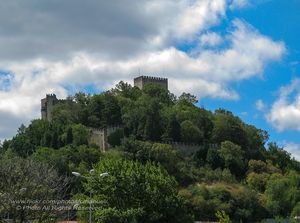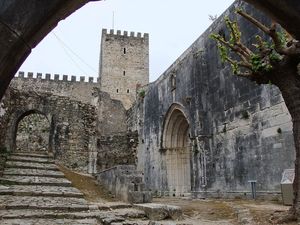
Leiria Castle
Dare exploring Leiria Castle in your tour of the centre of Portugal.
The Castle of Leiria has an extraordinary and strategic location, in a place already inhabited in Roman times, where the first King of Portugal, Afonso Henriques, built in 1135 this castle to defend the Southern frontier of his kingdom (Santarém and Lisbon still were under Arab rule).
After the reconquest of this two cities in 1147, the castle lost military importance and fell into ruin. In the 14th century, King Diniz rebuilt the castle to live in it with his wife, Queen Santa Isabel.
Now the castle is a monumental symbol of the history of the city. The architecture of the present buildings wa modified in the 16th century during a detailed restoration.
After entering the first enclosure of the castle, crossing a gate flanked by two imposing battlemented towers, you will find yourself in a lush and refreshing patio. To the left, you will find a staircase that leads to the heart of the castle. The Royal Palace is located in front of the keep. To the right, the Igreja de Nossa Senhora da Pena church, which was built in the 15th century still maintains an elegant Gothic style lanceolate presbytery and an archery decorated with Manueline motifs.
In the interior, you shouldn't miss visit the Torre de Menagem Keep Museum, where many archeological materials founded in the castle are exhibited, as well as replicas of medieval weapons.
The Royal Palace has many rooms that are well worth visiting. Inside, the stairs lead to a central gallery, formerly a royal balcony, from which wonderful views of the city of Leiria can be contemplated, through eight Gothic arches resting on the same amount of pillars.
More information:
Location:
Rua do Castelo, Leiria.
Ticket price:
Ticket to museum: 2.10€
Opening times:
Winter: From the 1st of October to the 31th of March from 9h30 to 17h30.
Summer: From the 1st of April to the 30th of September from 10h00 to 18h00.
Closed on mondays.
Telephone:
(+351) 244 81 39 82
Mapa Interactivo:
Leiria
What to see:
- Leiria Castle
- Buddha Eden Garden
- Cathedral of Leiria
- Igreja de Nossa Senhora da Pena Church
- Santo Agostinho Convent
- Nossa Senhora da Encarnação Sanctuary
- São Francisco Convent
- Praia do Pedrógão Beach
- Mira d'Aire Grottoes
- Santo António Grottoes
- Alvados Grottoes
- Serras d'Aire e Candeeiros Natural Park
Museums:
- Sporting Clube de Portugal Soccer Museum
- Museu do Moinho de Papel (Paper Mill Museum)
- Museu da imagem em movimento (Moving-image museum)
- City Farming Museum Dona Julinha
- João Soares House-museum Cultural Centre
- Freixial Ethnographic Museum
- Museu Escolar dos Marrazes Museum
- Museu do Casal de Monte Redondo Museum
Other worth-visiting nearby towns and cities:
Why "Portugal Travel"?
Portugal Travel is an organization of Portuguese agencies whose objectives are:
- ✓ To make Portugal, its culture and its heritage known.
- ✓ To promote sustainable tourism.
In collaboration with:
Escola Superior de Hotelaria e Turismo do Estoril
Turismo de Portugal
Copyright PortugalTravel.org © - All rights reserved.





